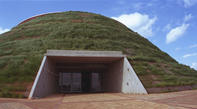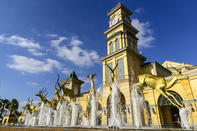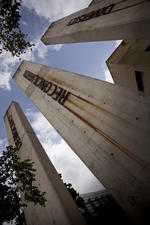Cradle of Humankind World Heritage Site
The Cradle of Humankind World Heritage Site covers a large area northwest of Johannesburg and incorporates several extremely important fossil sites. Sterkfontein, Kromdraai and Swartkrans caves.

Only the Olduvai Gorge in Kenya rivals it, so far, as a treasure chest of humanoid archaeology and palaeontology. The best known of these sites is Sterkfontein Caves, where the first fossils of australopithecine (man-apes who used tools) were identified.
The remnants of more than 950 individual hominids have been found, as well as of many other extinct creatures, such as sabre-toothed cats, giant hyenas and short-necked giraffes.
Gold Reef City

Apartheid Museum

A visit to the Apartheid Museum (next to Gold Reef City in Joburg) where most of the displays are audiovisual, is harrowing and overwhelming. Those who grew up during apartheid should visit for an uncensored look at the government-sanctioned racism, for the film footage the world saw but South Africa didn't; those born since the introduction of democracy should be taken to understand the forces that have shaped our nation.
You can also make a recording of your own experiences under apartheid and donate items that are now 'historical artefacts', such as passbooks and photographs. Pack Antjie Krog's Country of My Skull as your reading for the trip; her heart as a poet comes forth in her account of the Truth and Reconciliation hearings, with quotes such as General Constand Viljoen saying: "We all used violence to get what we wanted. The terror of the tyrant invited the terror of the revolutionary."
Liliesleaf Farm
Liliesleaf Farm in the Joburg suburb of Rivonia (usually described as 'leafy') was chosen because it was an unlikely place for the nerve centre of the anti-apartheid struggle. It saw the launch of Umkhonto we Sizwe (MK) and had a printing press in an outhouse producing struggle literature.
In 1963, in what the apartheid regime regarded as a major victory, several members of the ANC high command were arrested during a police raid following a tip-off, including Walter Sisulu and Govan Mbeki. Liliesleaf is no longer a secluded smallholding, but an upmarket guesthouse with a small museum, learning centre and retreat.
MuseuMAfricA

From the outside the building housing MuseuMAfricA still looks as it did when it was built in 1913 as a fruit-and-vegetable market. But inside it’s very modern, pillars driven into the soil support several floors which don't connect to the building's original outer skin.
The museum's exhibits have been accumulated since the early 1930s; today it's South Africa's premier cultural history museum. The focus of the permanent exhibitions is on urban life in Joburg through the various eras of South Africa's history.
Photographic Museum
More than just a photo gallery with changing exhibitions, the Bensusan Photographic Museum in Joburg showcases the development of photography, from traditional black-and-white to today's computer-assisted creations.Military Museum

This museum in Johannesburg opened in 1947 as a WW ll memorial. In 1975 it was renamed the South African National Museum of Military History, and repurposed to record all the military conflicts in which South Africans had served. Displays start with the Anglo-Zulu Wars, and include recent items from the Angolan conflict (the revolutionary G6 gun, Russian T-series tank), as well as the Umkhonto we Sizwe resistance era. By far the bulk of displays are from WW ll.
There are some very special exhibits, such as the ME jet night fighter, the only one of its kind left. But perhaps most poignant are the paintings of the seven official artists appointed to document that war, of which unfortunately only a handful of the 850 works are on view.
Always a favourite among Joburg schools as a field trip, the Military Museum at the Joburg Zoo should be visited by parents and out-of-towners too. With a collection of more than 44 000 items from some of the rarest aircraft in the world to armoured vehicles and even South African war art, it's a great day out.
Constitutional Court

The Constitutional Court, on Constitution Hill, is built on 'Joburg's Robben Island', the site of the Old Fort Prison Complex, commonly known as Number Four, where various liberation leaders including Gandhi and Mandela, and thousands of others were once held.
Walk up the Great African Stairs, built with the bricks from the demolished awaiting trial block, into Constitution Square and take a tour of the prison and court, a journey into our painful past and transition to democracy. Don't forget to climb up the Old Fort ramparts for a panoramic view across Joburg.
By David Bristow